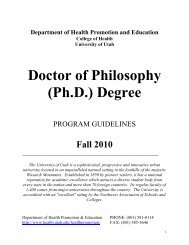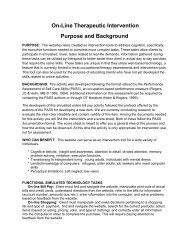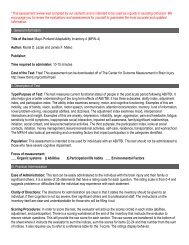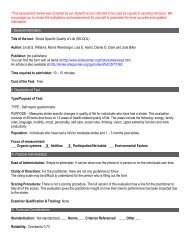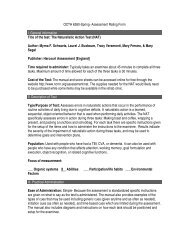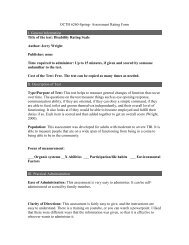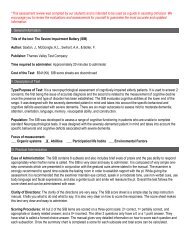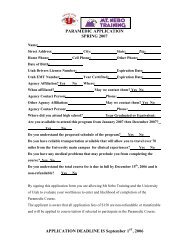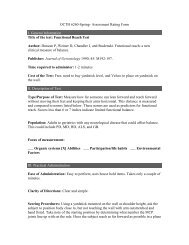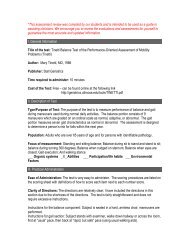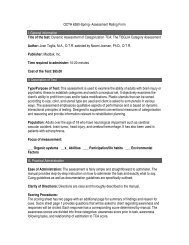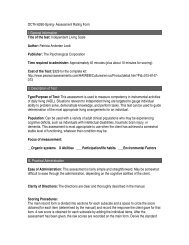Revisiting speech rate and utterance length ... - ResearchGate
Revisiting speech rate and utterance length ... - ResearchGate
Revisiting speech rate and utterance length ... - ResearchGate
You also want an ePaper? Increase the reach of your titles
YUMPU automatically turns print PDFs into web optimized ePapers that Google loves.
M. Blomgren, A.M. Goberman / Journal of Communication Disorders 41 (2008) 159–178 165presentation order effects, the order of presentation of the four tasks was r<strong>and</strong>omizedfor each participant. Specific information on the four experimental speaking tasksfollows.2.2.2.1. Length of <strong>utterance</strong>.a. Monosyllabic words. Forty-five monosyllabic consonant + vowel + consonant (CVC)words were presented via index cards to each participant to be read aloud. Thespecific CVC words were chosen to represent various word initial phonemevariations in voicing, place, <strong>and</strong> manner of articulation. Johnson <strong>and</strong> Brown (1935)have noted that for most individuals who stutter, the likelihood they will stutter on agiven word is strongly influenced by the word-initial phoneme. However, the specificphonemes that may lead to difficulty vary markedly from one individual who stuttersto another (Quarrington, Conway, & Siegel, 1962; Wells, 1983), so a broadrepresentation of word-initial phonemes was sampled. There is also evidence thatstuttering occurs more often on content words (nouns, verbs, adjectives, <strong>and</strong>adverbs) compared to function words (e.g. articles, prepositions, pronouns; Brown,1937; Eisenson & Horowitz, 1945; Quarrington et al., 1962; Wingate, 1979),therefore a majority of the words presented were content words. The words are listedin Appendix A.b. Short phrases. Each participant read aloud 45 three-word phrases presented via indexcards. Each word in each of the phrases was monosyllabic; therefore, all phrasescontained three syllables. In an attempt to partially balance the lexical content betweenthe word <strong>and</strong> phrase conditions, each phrase contained one of the 45 CVC words fromthe word task. The phrases are also listed in Appendix A.2.2.2.2. Speech <strong>rate</strong> stability.a. Stable (habitual) <strong>speech</strong> <strong>rate</strong>. During the stable <strong>rate</strong> <strong>speech</strong> tasks, participants wererequired to read all of the words <strong>and</strong> phrases at a steady, self-determined habitualspeaking <strong>rate</strong>.b. Unstable (variable) <strong>speech</strong> <strong>rate</strong>. During the unstable <strong>speech</strong> <strong>rate</strong> tasks, participants readthe same words <strong>and</strong> phrases as during the stable <strong>speech</strong> <strong>rate</strong> tasks. For this task, eachtoken was read using variable <strong>speech</strong> <strong>rate</strong>s, which r<strong>and</strong>omly alternated between slow,habitual, <strong>and</strong> fast. Fifteen of the 45 words were produced at a fast <strong>rate</strong>, 15 at a normal(habitual) <strong>rate</strong>, <strong>and</strong> 15 at a slow <strong>rate</strong>. Rate cues (‘‘fast,’’ ‘‘normal,’’ or ‘‘slow’’) wereprinted on the lower left corner of each card.Before performing the experimental speaking tasks, each participant viewed a videotapecontaining demonstrations of the tasks. The videotape displayed an adult male speakerproducing five words <strong>and</strong> five phrases at slow, habitual, <strong>and</strong> fast <strong>rate</strong>s. Thedemonstration words <strong>and</strong> phrases were different from those used in the study. Slow<strong>rate</strong> of <strong>speech</strong> was produced at a <strong>rate</strong> of approximately one syllable/s. Habitual <strong>rate</strong> wasmodeled at approximately two syllables/s, <strong>and</strong> fast <strong>rate</strong> was modeled at approximatelyfour syllables/s. This videotape was presented as an example of the tasks, <strong>and</strong>



